Talking About my Bones: Typing with Radioulnar Synostosis
I’ve got something interesting about me: my bones don’t quite work right!
Put your arm straight out in front of you, with your hand limp. Now rotate your hand until your palm points upward. This motion is called ‘supination’. You’d think this motion happens in your wrist, but it actually happens in your elbow. Your radius and ulna twist around each other, allowing for rotation.
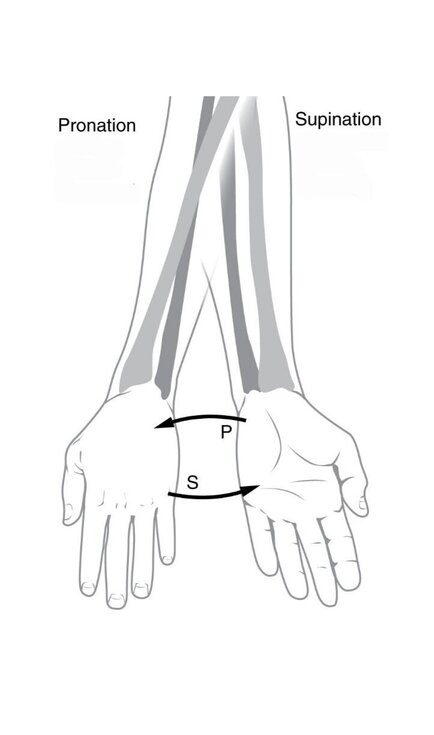
Unless you’re me! My radius and ulna are fused together. Instead of being able to move my hand relative to my forearm, it is always at about a 40 degree angle.
I’ve been like this since I was born, and I have it in both arms. So to give the full description of my condition (and for SEO so someone might be able to find this) is Congenital Bilateral Radioulnar Synostosis. Radioulnar Synostosis (or RUS) is extremely rare, so the condition is under researched.
The rest of this post will be about how I manage this condition. It’s intended to be part education for people without RUS, a collection of resources for the couple of hundred of us with RUS.
A lot of this depends on where exactly an individual’s hand is positioned relative to their arm. This will be drawn from my own personal experience.
For most everyday tasks, I find this condition is manageable. Things like cooking, cleaning, and eating aren’t really impacted. Sometimes I’ll have trouble with a drawer that has one of these handles:
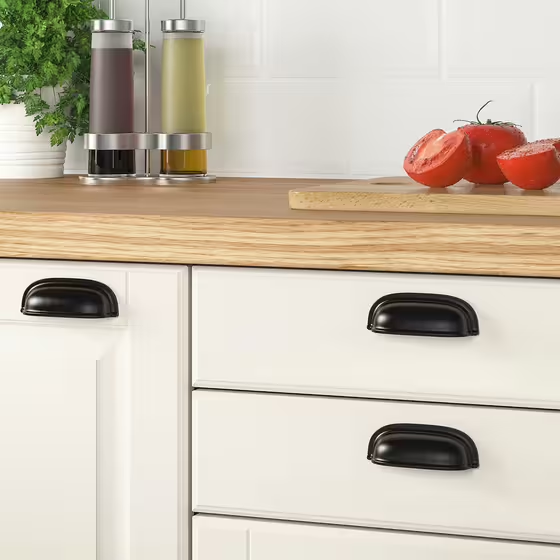
Because I can’t get my hand up into it! Other tasks like carrying a pizza box, eating with chopsticks, and taking loose change from a cashier are annoying but doable.
Operating a steering wheel can be awkward, so currently I’m using a steering wheel spinner:

This prevents me from having to pinch the steering wheel between my thumb and index finger during long car trips.
Using a Computer
I have typed all day every day, pretty much continuously for the last ten years.
For most of that, I was using one of these bad boys:
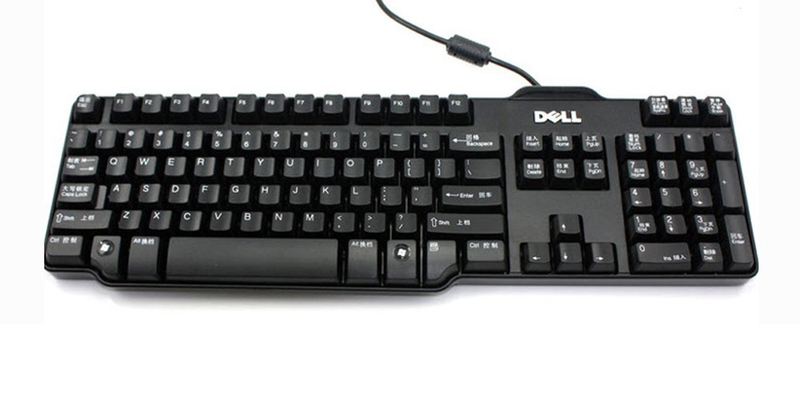
I used a typing method that was only slightly faster than hunt-and-pack, mostly because I wasn’t able to comfortably put all my fingers on the home row!
About three years ago, for the first time, I had a budget available to get a keyboard that wasn’t from a second-hand store. I tried out a Knesis freestyle 2. This was significantly better than a traditional keyboard, becuase I could angle the halves away from each other.
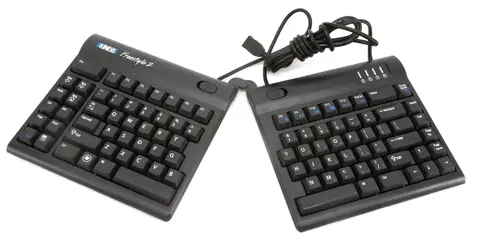
Hooray! Problem solved, right?
After using the Freestyle 2 for a year or so, I developed severe pain in my wrists and thumbs. I don’t think it was directly related to that specific keyboard, the years of trying to use tools that weren’t right for me had finally come back to haunt me.
At this point, I was so worried. Would I have to begin a different career? One that didn’t involve a computer?
During this period, I tried everything. I experimented with every angle I could think of for this Freestyle, but nothing seemed to help.
Talon
Eventually, I found Talon Voice. I used it for a few months, with better success than I expected! Talon has excellent voice recognition and a very streamlined grammar that lets you navigate a computer with very short commands. If you want to learn more about Talon, this article was a great getting started resource for me.
Twiddler
I also experimented with the Twiddler 3. The Twiddler is interesting because, in theory, it lets you operate a computer entirely with one hand, which can be positioned wherever is comfortable. You type by pressing up to four buttons at the same time. in practice, I had trouble remembering the key combinations, so I don’t really use it much. I would like to get back into it though. If a one-handed keyboard is what you’re looking for, I think Twiddler is the best possible hardware that is out there.
Getting Treatment
While experimenting to see if I could solve my issues on my own, I also sought medical help. After a few months (thanks American healthcare system!) I met an Occupational Therapist. I had a fantastic experience with mine, and I highly recommend anyone with RUS and access to healthcare see an Occupational Therapist. I was the first person she had ever met with this condition, but we were able to work together and discuss what accommodations I could try.
Posture
Ideally, your posture when typing should look like this:
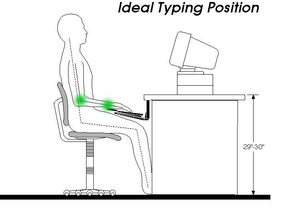
Everything should be at about 90 degrees, especially your elbows.
Since all the typing advice out there assumes you have a typical range of motion, I ignored this advice and tried everything. I tried lowering my chair so the desk was at chest height, and putting my elbows on the table and typing like I was playing the bongos. I tried attaching my keyboards to the armrests of my chair.
Turns out, bad posture like that was causing a portion of the pain I was experiencing. My OT recommended that I keep to a typical typing posture wherever I could. With my arms hanging down at my sides, and my elbows bent at 90 degrees, that leaves exactly one spot for my fingers to be.
That led to the keyboard setup I’ve been using since then:

A ZSA Moonlander on a 3d printed tent kit, with the thumb clusters removed.
Removing the thumb cluster surprised me, it was one of the reasons I was drawn to the Moonlander in the first place.
Thumbs
It turns out that when you don’t have a full range of mobility, your body learns to compensate in other ways. In my case, I have hypermobile thumbs.

Specifically, my Metacarpal tends to float freely out of the CMC Joint. The extra mobility compensates somewhat for my lack of rotation but can result in pain. The recommendation my OT gave was to do Thumb Stability Exercises.
Note: I’m not your doctor! Even if you’re in a situation similar to mine, don’t do these exercises without the direction of a medical professional.
Additionally, my hand size and rotation means that the typical thumb cluster of the Moonlander, and thumb clusters in general, were making me move my thumbs in a way that hurt more than it helped. Thankfully, they’re designed in a way that they can be removed completely.
Desk & Chair
The final thing I changed was my desk and chair. I’ve always just used whatever I could get my hands on. A random desk and whatever executive-style chair I could find in the trash.
But it turns out that executive-chairs are made for people who are tall! The arm rests assume you’re at least 6 feet tall, so if you’re shorter than that, you can’t wrest your elbows on them without splaying them out slightly. For me, that means a change in my typing angle, and we can’t have that.
My office was giving away some of their old office chairs, so I was able to snag an old Herman Miller Sayl chair, which has removable arm wrests.
I ended up pairing this with a used Autonomous Adjustable desk, with a keyboard tray from Uplift.
Besides the benefit of being able to stand sometimes, the real benefit for me with a standing desk is that I can easily tweak the exact height of the keyboard. Sometimes I find that adjusting a few millimeters up or down can help ease any building tension.
Conclusion
This whole journey took well over a year. I’m grateful I was able to take the time and figure out what worked. Here are my key takeaways:
Listen to your body
It took me an embarrassingly long time to notice I was having pain. If I noticed earlier and gotten help sooner, this process would have been much easier
Ergonomics is hard
I had to learn a lot of things to get a system that worked. I wish there was more advice available online for people with unusual conditions looking for accommodations.
Take long-term breaks
When I was trying out Talon Voice, I didn’t type for about two months. I really think my body needed that time to heal from my injuries. I’ve seen others with pain conditions from typing talk about how taking an extended break can really help. Talon is nice because it allows some computer use during that healing process.
Be willing to change
Who knows, in ten years I may need to go through this process if my pain re-occurs. But I feel like I’m ready for it if it does happen.
Thanks for reading :)